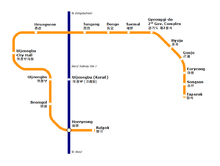U Line
| ||||||||||||||||||||||||||||||
The U Line is a completely driverless, fully automatic, grade separated rapid transit in Uijeongbu, Seoul Capital Area, South Korea. The "U" stands for the city Uijeongbu. The line uses Véhicule Automatique Léger 208 trains built by Siemens Transportation Systems. The system is identical to the Toulouse Metro in France .
The line is 10.588 km (6.579 mi) long on elevated track and offers a transfer to Line 1 at Hoeryong Station. Single rides cost 1,300 won. During rush hours trains come every 3 and a half minutes with trains coming every 6 to 10 minutes during all other hours. Trains are in service 19.5 hours a day, from 5 am until 12:30 am.[1][2] From Balgok Station to Tapseok Station the U Line will take riders 19 minutes and 54 seconds, versus a car at 31 minutes 6 seconds or a public bus taking 40 minutes and 6 seconds.[3] Two extensions are planned.[4]
History

- 1995 December – Initial planning
- 2004 August – GS Construction Consortium is picked
- 2005 October – Operating company is established
- 2007 July – Construction groundbreaking ceremony
- 2007 August – Full construction begins
- 2011 Summer – All track has been laid
- 2011 Fall – Signal work completion
- 2012 February to June- Testing of system
- 2012 June 29–30 – Free rides prior to official opening [1]
- 2012 July 1 – Revenue service begins[5]
Fares
The U Line is physically connected to the Seoul Metropolitan Subway system and allows payment via the T-money smart card. While it does not allow free transfers to other lines or buses as of 2013, free transfers will be introduced from 2014.[6] Discounts are available for youth and free rides exist for those over 65 years of age. There is no deposit fee added to the purchase of a ticket. Prices begin at 1,300 won except for the month of November 2012 where temporary prices were set at 350 won for general tickets, 300 won for youth, and 230 for children.
Ridership and finances
In 2006, the line was forecast to serve 57,000 passengers daily, a figure cut to 31,000 in 2011. Built at a cost of 547 billion won ($469 million), the financial viability of the line has been questioned, with one study estimating that it will require subsidies of 10 billion won per year for at least a decade.[7]
As of 2012, 32 million passengers a year are expected, increasing to 55 million by 2040.[4]
Stations
Please note there is no Station #116.
| Station number |
Station name | Transfer | Line name | Station distance |
Total distance |
Location | |||||
|---|---|---|---|---|---|---|---|---|---|---|---|
| Romanized | Hangul | Hanja | in km | ||||||||
| U110 | Balgok | 발곡 | 鉢谷 | |
|
|
|
| |||
| U111 | Hoeryong | 회룡 | 回龍 | Line 1 | |
| |||||
| U112 | Beomgol | 범골 | 범골 | |
| ||||||
| U113 | Uijeongbu | 의정부 | 議政府 | |
| ||||||
| U114 | City Hall | 의정부시청 | 議政府市廳 | |
| ||||||
| U115 | Heungseon | 흥선 | 興宣 | |
| ||||||
| U117 | Uijeongbu Jungang | 의정부중앙 | 議政府中央 | |
| ||||||
| U118 | Dongo | 동오 | 東梧 | |
| ||||||
| U119 | Saemal | 새말 | 새말 | |
| ||||||
| U120 | Gyeonggi Provincial Government North Office | 경기도청 북부청사 | 京畿道廳 北部廳舍 | |
| ||||||
| U121 | Hyoja | 효자 | 孝子 | |
| ||||||
| U122 | Gonje | 곤제 | 昆弟 | |
| ||||||
| U123 | Eoryong | 어룡 | 魚龍 | |
| ||||||
| U124 | Songsan | 송산 | 松山 | |
| ||||||
| U125 | Tapseok | 탑석 | 塔石 | |
| ||||||
See also
- Subways in South Korea
- Seoul Metropolitan Subway
References
- ↑ 1.0 1.1 "의정부경전철 개통 및 이용안내" (Korean). Opening Info. U Line. Retrieved 2 July 2012.
- ↑ "운영정보" (Korean). Operating Info. U Line. Retrieved 2 July 2012.
- ↑ "노선안내" (Korean). Time differences and station names in Korean. U Line. Retrieved 2 July 2012.
- ↑ 4.0 4.1 David Briginshaw (July 2, 2012). "Korean city opens automatic light metro". International Railway Journal. Retrieved July 10, 2012.
- ↑ "시행사소개" (Korean). History page. U Line. Retrieved 2 July 2012.
- ↑ 경기도 '용인·의정부'경전철 통합환승 손실 지원받는다, The Asia Economy Daily, April 5, 2013.
- ↑ "Light rail opens in S.Korea amid financial fears" (News website). Bangkokpost. June 17, 2012. Retrieved 2 July 2012.
External links
- UrbanRail.net's Seoul Subway page
- Official U Line Website (Korean)
- U Line Naver Blog (Korean)
| |||||||||||||||||||||||||||||||
| |||||||||||||||||||||||||||||||||||||

